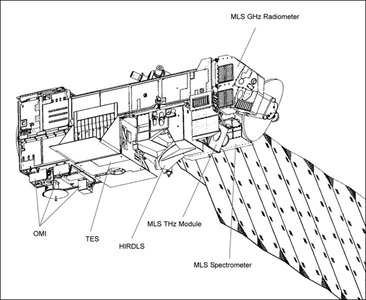Source: NASA
Earth Observing System - Aura

What's good? What's safe? What's harmful?
Earth's climate is regulated, in part, by atmospheric chemicals. The complex interactions of these gases, both naturally occurring or human-made, may be contributing to global change. Until we know the long-term effects of industrial emissions and such natural phenomena as volcanic eruptions, we can only guess their impact. We may presume damage where there is none; we may overlook subtle hazards.
An Earth Observing System satellite - EOS Aura - will help clear the air of guesswork. It hosts a suite of scientific instruments designed to make the most comprehensive measurements ever undertaken of trace gases in the environment that surrounds earth. The satellite's orbit will allow measurements to be taken at all latitudes; instruments will make continuous scans at altitudes ranging from the stratosphere down through the troposphere

Earth Observing System - Aura
Data from the satellite's instruments will focus on such timely issues as the effects of increased industrialization in developing nations, large-scale biomass burning, ozone depletion and El Nino conditions. EOS Aura will also map trace gasses resulting from organic decay, lightning and volcanic eruptions, and study the chemical dynamics of the atmosphere over all geographic areas and seasonal climates. Their findings will give scientists data needed to identify and assess the roots of global change.
The EOS Aura satellite is based on Northrop Grumman's EOS Common Spacecraft, the same platform hosting NASA's EOS Aqua mission. The versatile spacecraft is modular with common subsystems and easily adapted to the mission-specific needs of EOS Aura, EOS Aqua and future earth observing missions.
Contact Us
William Furlong
(310) 814-8395

